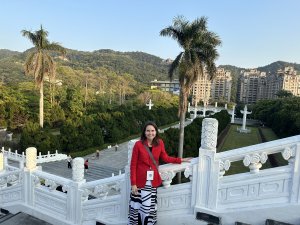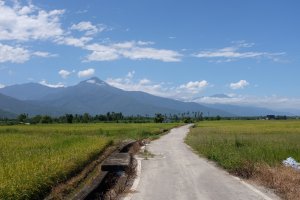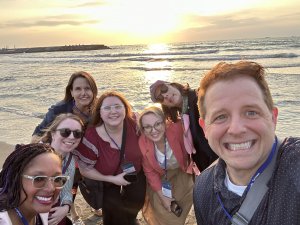I studied in the Department of Occupational Therapy at Boston University for my Master’s and Doctor of Science degrees from 1996 to 2000. In my dissertation research, I examined how to manipulate experimental conditions to enhance movement of people with Parkinson’s disease (PD). To recruit participants for my research, I went to several PD support groups and observed the active role of local support groups in the US. However, when I returned to Taiwan, I found that PD support groups were not common there. Our university hospital used to hold PD support group meetings, but after the hospital social workers asked the people with PD to run the support group themselves, they never met again. Therefore, I would like to take the opportunity while being a Fulbright scholar in the US to go to PD support group meetings to learn more about these resources and how they influence the lives of people with PD, hoping to find ways to facilitate support groups in Taiwan.
Through my host professor’s connection, I scheduled a visit to a PD support group meeting in a rehabilitation hospital in New Hampshire in mid November 2014. The following is the description of that day, including the physical setup of the rehabilitation hospital, the PD support group meeting, my interaction with them, and my reflection after this visit.
Northeastern Rehabilitation Hospital at Pease
My colleague and I arrived on a sunny day. We were impressed by the physical environment. They have rehabilitation space setup like the real-world environment, such as a car and trolley for patients to practice getting on and off. They also have rooms that were set up like our bedroom, bathroom, and kitchen, so patients can practice various activities of daily living, such as cooking, dressing, bedding, cleaning, doing laundry, and moving in and out of a tub. They also have a therapy garden and an outdoor mobility park to challenge patients with varied terrains and obstacles they would need to navigate when returning home or going to the workplace.
In their inpatient department, a considerate design is that part of the wall is concaved, so medical supply carts can be put there and the walkway is not blocked. Also, they keep the ward quiet and the air fresh, so you would not hear a lot of noise or smell disinfectant spray like in other hospitals. The staff said that they did research before building the hospital and that they paid special attention to keep the environment comfortable to help patients get good rests for their recovery.
For the inpatient department, they have space for occupational therapy (OT) and physical therapy (PT), so patients can receive the rehabilitation service closed to their wards. Each inpatient receives at least 3 hours of rehabilitation service per day. And interestingly, pet therapy is also provided in this hospital.
PD Graduate Group
Here they offer a LSVT (Lee Silverman Voice Treatment) LOUD, an intensive speech therapy program, to improve the quality of voice and speech, and LSVT BIG, a comprehensive PT/OT program to promote walking, balance activities, and daily activities. Those programs are offered 4 days/week for 4 weeks. After people with PD graduate from this program, the hospital offers a once-a-month group exercise session that ensures proper home carryover of all learned techniques. This is the support group meeting I visited.
This “graduate” group meeting can roughly be divided into two sessions, support group meeting and exercise. In the support group meeting, they discuss issues related to their life. For example, on that day we visited, they discussed issues related to management of medication when traveling by plane.
In the exercise session, an OT therapist led group members to review the exercise they had learned in the LSVT BIG, and emphasized force and large amplitude of movement. Then the Speech Pathologist guided them through some basic vocal exercise they had learned in the LSVT LOUD.
Because the OT knew my purpose of this visiting, she asked the group members what they considered as essential components of a successful support group. The attendees gave some great points. In summary, they highly regarded the therapist for her enthusiasm, warmth, and humor, and her charming personality motivated them to come back again and again. In addition, they valued the opportunity to be able to get together with other people with PD, as they had become friends. They also enjoyed that when they came back, they could not only chat, but also did exercise together, as a review of their learning in the past LSVT programs. Also, an important thing is that they felt relaxed when coming back, rather than being pushed to do something.
What I learned from their comments is the importance of healthcare professionals working with people with PD to run the support group, rather than giving all the responsibility to them all at once. This is an important lesson for me.
In addition to the comments I got on that day, I also received an email forwarded by the therapist from a man with PD. Before our arrival, the therapist had announced our visit to the members by flyers, saying “All the way from Taiwan…… Parkinson’s Researchers & Fulbright Scholars to attend the next LSVT Graduate Group on November 19, 2014!” So one of the group members, who had lived in Hong Kong for more than 20 years, wrote an email about his experience of diagnosing, treating his PD in Hong Kong, as well as his experience of attending support group meetings there. He made insightful comments such as:
“Chinese families faced a number of cultural issues with PD including a reluctance to publicly admit they had a family member with the disease,”
There was also a great reluctance to discuss with others the challenges faced by caregivers/family members,”
The “PD Help group focused on outings to area attractions such as free trips to HK Disneyland, HK Ocean Park, etc.”… “These outings fostered the development of personal relationships where I observed people sharing with each other the various challenges faced by PD patients and their families/caregivers.”
After the discussion about essential components of a successful support group, it was time for me to present my research and clinical work in Taiwan. I started with where I am from and a brief introduction of where Taiwan is. Then I told them a story when I was doing my first experiment on people with PD. I remembered a young man with PD, who helped me to get participants for my study. Through him I extended my gratitude toward those people with PD who came to my research, who shared their stories with me, and who welcomed me to their support group meetings, just like the people I met on that day. Those experiences reminded me that I have the responsibility to contribute to the PD community.
Then I talked about my research in Taiwan. As I am an occupational therapist, I focused on functional arm movements and examined the effect of adapted utensil, background noise, handwriting direction, and moving targets on movements in people with PD. I shared the main findings of my research, with a word of caution that my research was done on Taiwanese people with PD at Hoehn and Yahr stage 1 ~3 (severity of PD), and thus might not be generalizable to people with PD in the US. For my clinical work in Taiwan, I said that although Taiwan has a universal healthcare plan, which allows people to see a doctor and to get medication easily, not many people with PD have received rehabilitation service. Most patients seen in the Department of Rehabilitation are adults with cerebral vascular accidents, spinal cord injury, and traumatic brain injury. Not many physical medicine doctors see and understand the needs of people with PD.
The feedback from the therapists and attendees is that a similar situation happens in the US, too. Therefore, it is important to educate the doctors about PD, and one of the best way to do this is to let the patients tell doctors the improvements after they receive the rehabilitation service.
After my presentation, there were some questions and comments from the audience. They asked about the prevalence of PD in Taiwan, as well as the effect of Chinese Medicine as a complementary alternative treatment. Some people asked about practical implications of my research findings. For example, one lady was interested in my research findings that moving targets can enhance movement speeds of people with PD, and that the effect is similar in virtual reality and physical reality. Although the virtual reality scenes were developed by our research team in the study, I believe other commercially available virtual reality games that provide moving targets as visual motion stimuli should have beneficial effects, too.
Reflections
Many people with PD that I met on that day kept telling me that they benefited a lot from this group. Although it was good to hear their positive feedback, it is also important to think about the therapeutic mechanism underlying this support group. After some discussions with my host professor at Tufts University, Dr. Tickle-Degnen, and reading some papers, I have the following comments:
1. The focus of LSVT LOUD & BIG programs is to train people with PD to make large and forceful movements consciously, because it was said that people with PD had problems with automatic movements. However, we also noted that the training programs expect that people with PD can do large and forceful movements automatically one day after training and practicing. Therefore, it seems conflicting regarding the automatic control of movements in PD.
2. Given the insufficient evidence for large and forceful movement, it cannot be overlooked that rapport between the therapist and clients with PD might also contribute to the positive outcome of this support group, according to the positive feedback the group members provided regarding their therapist.
3. Although many studies focused on motor symptoms of PD, non-motor symptoms, such as depression, fatigue, and cognitive decline, has garnered growing attention. Moreover, recent research indicates that motor performance is associated with cognitive function. For example, gait is associated with executive function in PD. It is difficult to expect improvement in one dimension (e.g., gait) without also addressing another (e.g., executive function). Therefore, multimodal training interventions is needed to address multiple performance skill areas and functional activity performance in people with PD.
Reference: Foster, E. R., Bedekar, M., & Tickle-Degnen, L. (2014). Systematic review of the effectiveness of occupational therapy– related interventions for people with Parkinson’s disease. American Journal of Occupational Therapy, 68, 39–49.





